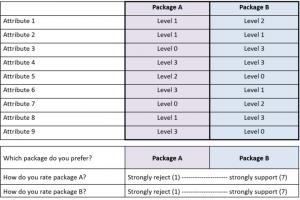- This topic is empty.
-
AuthorPosts
-
30. June 2022 at 23:30 #1486Annina ThallerGuest
Dear Unipark team,
in our survey we would like to include a fully randomized choice experiment with 9 attributes and four possible levels per attribute. Every participant has to assess six comparisons of two alternatives each.
In previous questions, I only found solutions for factorial designs, where images of the limited pre-selected number of choice sets were prepared beforehand. As mentioned, this is not possible in our case, as the number of potential combinations is too high.
Do you have a suggestion how to solve this problem?
Many thanks, Annina
P.S.: See picture below how a final page shoud look like
 30. June 2022 at 23:36 #1489David ThulGuest
30. June 2022 at 23:36 #1489David ThulGuestHello Annina,
you could implement the planned project as follows:
Create two static lists (one list per package).
Static list 1 (Package A)
Static list 2 (package B)
Then you create the corresponding list elements within the respective list:
Static list 1
Package A: Attributes 1 / Level0 -> always in random selection
Package A: Attributes 1 / Level1 -> always in random selection
… and so on
Static list 2
Package B: Attributes 1 / Level0 -> always in random selection
Package B: Attributes 1 / Level1 -> always in random selection
… and so on
Now we have two static lists, which are filled with the required list elements. The list elements are randomly selected via the inclusion condition (always in random selection)
For the next step you have to create 12 user-defined variables.
We need 6 user-defined variables per package (6 for package A, 6 for package B)
We let these user-defined variables be filled via a list trigger.
For this, we create two list triggers on a page that is sure to be seen by all people (who are supposed to answer the question).
Type: List Trigger
Execution position: directly
Condition: execute always
IMPORTANT: Check ”randomize list elements” (second blue underline)
These triggers ensure that the label of the respective list elements is written into the user-defined variables when the trigger is triggered.
Finally, you can output the user-defined variables (which are filled via the list triggers) via the corresponding placeholders within a matrix question.
Please check extensively how the corresponding approach can be evaluated for you.
Tip: Create another 12 user-defined variables and have them filled with the element number instead of the label.
Kind regards
David
-
AuthorPosts
- You must be logged in to reply to this topic.
